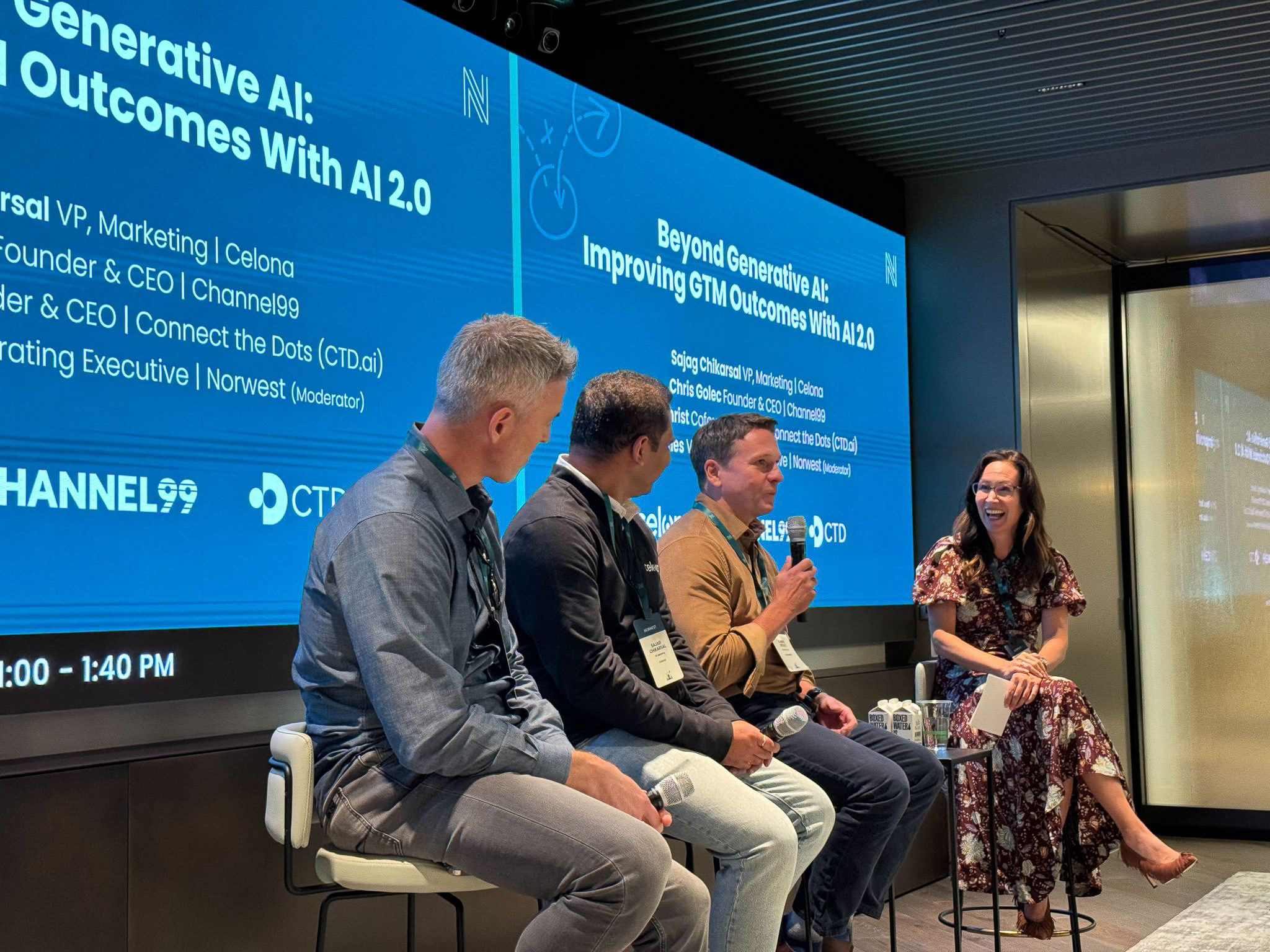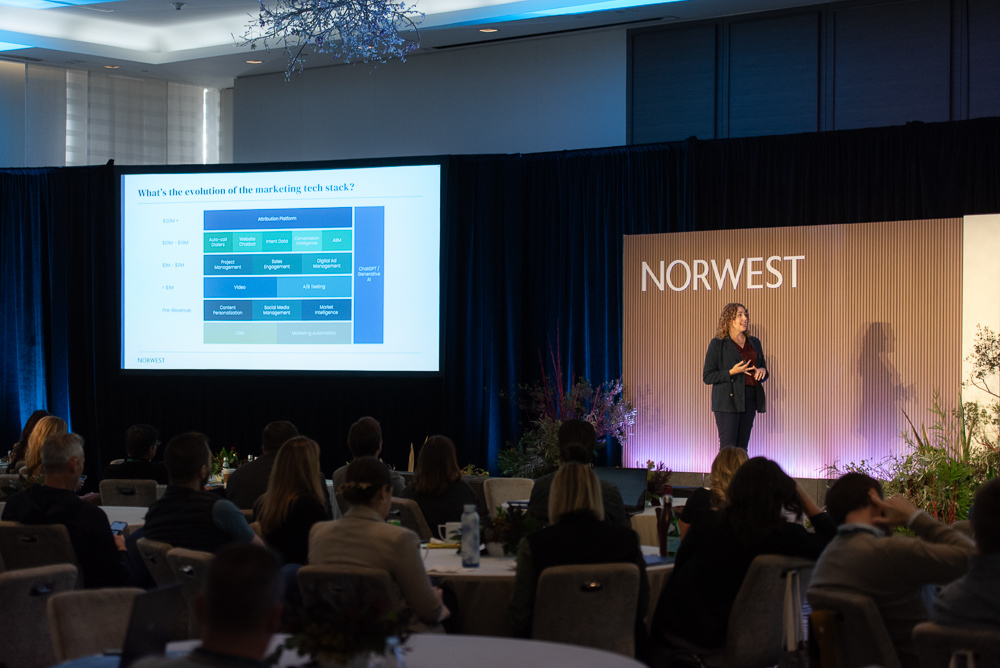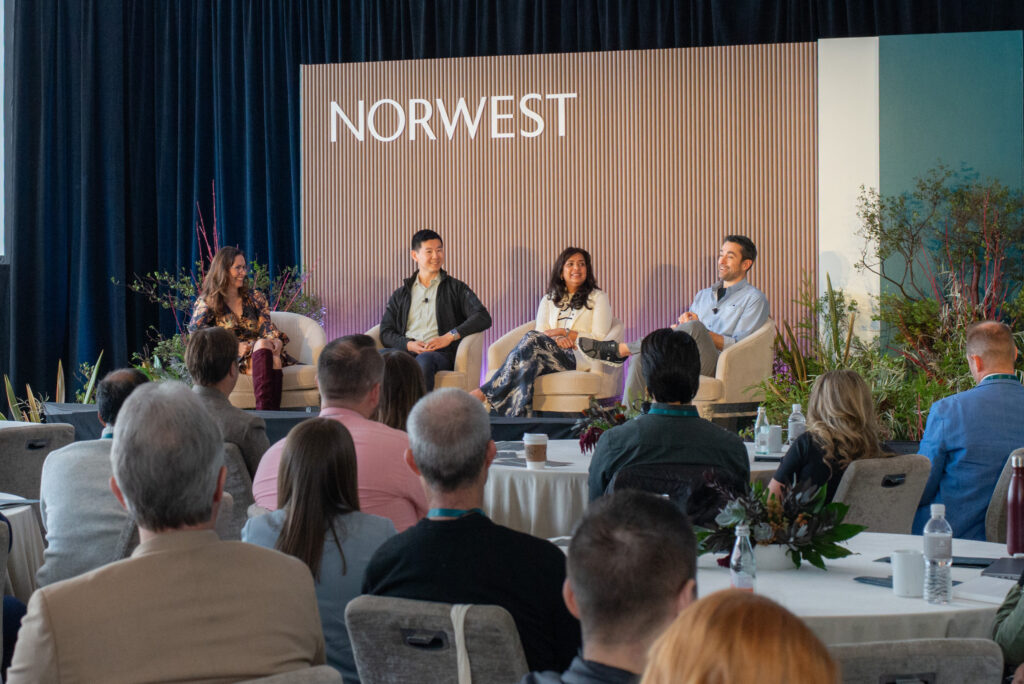Driving growth is the universal business challenge. At Norwest, we are fortunate to have a rich diversity of B2B, B2C, and B2B2C companies in our portfolio, and they all share the need for effective go-to-market strategies that drive customer acquisition and sales. Fortunately, the community of marketing leaders in our portfolio is also eager to share their brand-building insights with each other, which is what makes our annual Growth Marketing Summit so enriching.
As Senior Managing Partner Jeff Crowe said in his welcome address to the marketing leaders gathered in Menlo Park for this year’s event, “What we have in this room today is a collective wealth of expertise, ideas, and experiences across so many industries—and that’s where the magic happens.”
The event produced endless learnings and inspiration for building strong brands, partner ecosystems, sales pipelines, and marketing organizations. Here are just a few of the insights that caught our attention.
Customers Build Brands
Our keynote established a key overarching theme: a strong brand is a force multiplier. How can companies lean into that asset? Maura Rivera, CMO at Qualified, emphasized grassroots authenticity and user-generated content marketing: “Customers should be the loudest voice when it comes to talking about your brand.”
Her company uses a flywheel of customer testimonials to illustrate product features, which in turn helps generate even more rave reviews.
Talkspace’s CMO, Katelyn Watson, took a similar approach to refreshing her company’s legacy brands. End users provided testimonials by phone—a low-production yet highly effective approach. Tapping into social content like threads on Reddit and Quora helped her team capture genuine customer sentiment.
“Onlyness”: The Powerful Positioning Pillar
Chandar Pattabhiram, Workato’s chief go-to-market officer, distilled his hard-won wisdom on positioning down to a few key lessons. After identifying one word or attribute to associate with your brand, choose a marketing approach—category marketing for a new category, or referential marketing if entering an established space with well-known incumbents. (Think “Salesforce.com is Amazon.com meets Siebel systems.”)
Then it’s all about your “onlyness,” crystallizing something that only your company can provide to the buyer and staying focused on it throughout your GTM. Along the way, be sure to cultivate a community of brand champions who can be advocates in the sales cycle.
The Secret to TikTok Success: Think Small
Authenticity is especially important on TikTok, where the most popular videos are often the least flashy. Dave Crosby, co-founder and CMO at Wyze, recommended spreading your TikTok budget across thousands of smaller-scale videos and counting on a few to take off rather than taking a big swing with a single hero video. This can take time, of course. “If you’re just trying to make a quick profit, this platform may not be right for you,” he advised.
Evangelists Can Build Bridges—and Moats
If one happy customer is good for a brand, a flock of them is even better. “Community is a way to break through the noise,” said Shawn LaVana, CMO at Enable. “It gave us a competitive advantage, creating a moat that’s hard to overcome.”
How do you gather and energize that flock to build brand trust? “Hiring an evangelist was the best decision we made. He spoke their language.”
In Partner Marketing, Size Isn’t Everything
A partnership with a top-tier technology partner can seem like a dream come true—but that wasn’t the experience of Dario Ambrosini, CMO at Propel: “They loved our message, took our calls, and did everything we wanted except bring us pipeline.”
Realizing they needed tighter alignment with partners to motivate them to sell Propel, the company brought a dedicated solution engineer onto its partner marketing team. With compensation based on pipeline generation, the solution engineer engages in deeper technical discussions with partners, finds creative ways to use their products together, and drives sales that benefit both companies. The result: Propel’s pipeline generation has doubled.
Treasure Ops Can Turn High-Intent Leads into Gold
“Account-based marketing without intent is just outbound marketing,” said Gary Sevounts, CMO at Simpplr. The “Treasure Ops” approach he has developed lowers customer acquisition cost (CAC) and increases revenue by identifying the highest-intent leads in the company’s pipeline, then nurturing them closely. A culture of extreme ownership—and stage-by-stage incentives—keeps BDRs, SDRs, and product marketing staffers working together all the way to the close.
At Sevounts’s previous company, Treasure Ops generated $90 million of pipeline in six months. At Simpplr, a one-month pilot created $1.4 million of late-stage pipeline—and kicked off an ongoing strategic shift to Treasure Ops.
CAC Is a Business Metric—Not Just a Marketing One
CAC can be a useful metric for evaluating channels, but it can also be a trap for growth marketers. After all, CAC naturally rises as the volume of customers increases. “If growth is the goal, you can’t say that the lower the CAC is, the better,” pointed out Tyler Elliston, founder and marketing strategist at Right Side Up. “It’s like running—you can train with a long run for endurance or track work for speed. You can’t do both at the same time.”
Elliston recommends viewing CAC more holistically as a company-wide metric that offers insight into not just marketing efficiency, but also customer satisfaction, product quality, and other cross-functional variables.
Events Can Deliver Bang for the Buck—Even on a Budget
You can’t beat face-to-face contact for establishing credibility in a competitive space. When Sedai VP of Growth and Product Marketing John Jamie found traditional channels like pay-per-click and SEO overcrowded with incumbents, he turned to trade shows to build relationships and influence customer decisions.
Even with a small booth, simple tactics like clever giveaways (Sedai offered a Lego set as a prize) can be highly effective. In fact, one small event produced seven meetings and $500,000 in pipeline. “We spent a couple thousand dollars on travel, so we got a 200-to-one return,” said Jamie. In addition, the company’s own conferences featuring high-profile speakers have helped build its credibility and generate social and thought leadership content.
Jamie’s experience echoes the findings of the 2024 Norwest Marketing & Sales Benchmark Report. Previewed at our summit, the report found trade shows particularly popular and effective for generating brand awareness for high-growth companies.
AI Can Help—Sometimes
No event (or blog) these days would be complete without at least mentioning AI. What are our marketing leaders learning about the capabilities and possibilities of AI in marketing?
Sajag Chikarsal, vice president of marketing at Celona, has used a Gen AI voice tool to turn presentations into podcasts—and then translate them into multiple languages. “The speed at which you can scale content and the quality of output is just amazing,” he said.
“Humans are still better writers and designers,” said Chris Golec, founder and CEO at Channel99. “But in marketing operations, AI will be much better at synthesizing information about trends and performance nuances to predict the future. All those legacy attribution models haven’t worked. So that’s a huge opportunity.”
Drew Sechrist, co-founder and CEO at Connect the Dots, highlighted the importance of focusing on the data that drives value for your business rather than reinventing the entire AI wheel. “We’re not going to go build our own foundational model,” he said. “That means we need to pump in all the data that an existing model needs to be able to do the thing we need it to do. What we need right now are plumbers.”
Thanks again to all the speakers, attendees, and Norwest team members who made our 2024 Growth Marketing Summit such a wonderful event. We can’t wait to learn from our leaders again next year!





